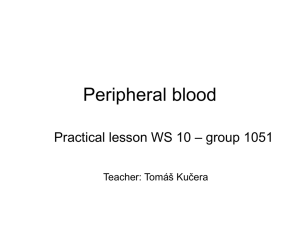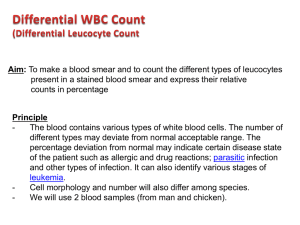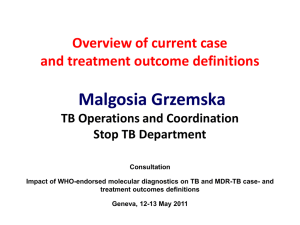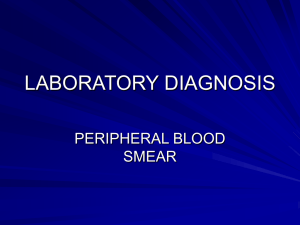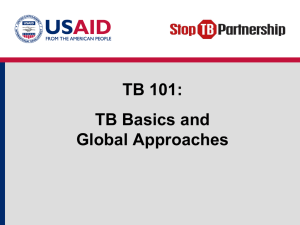BLOOD SMEAR PREPARATION AND STAINING
advertisement
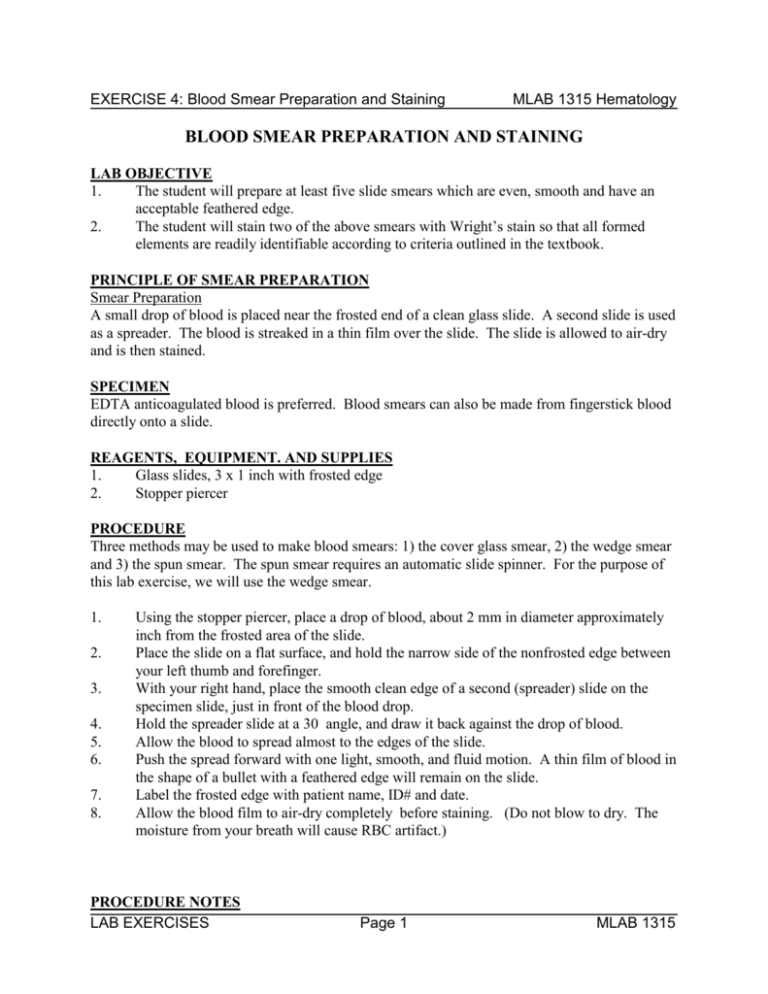
EXERCISE 4: Blood Smear Preparation and Staining MLAB 1315 Hematology BLOOD SMEAR PREPARATION AND STAINING LAB OBJECTIVE 1. The student will prepare at least five slide smears which are even, smooth and have an acceptable feathered edge. 2. The student will stain two of the above smears with Wright’s stain so that all formed elements are readily identifiable according to criteria outlined in the textbook. PRINCIPLE OF SMEAR PREPARATION Smear Preparation A small drop of blood is placed near the frosted end of a clean glass slide. A second slide is used as a spreader. The blood is streaked in a thin film over the slide. The slide is allowed to air-dry and is then stained. SPECIMEN EDTA anticoagulated blood is preferred. Blood smears can also be made from fingerstick blood directly onto a slide. REAGENTS, EQUIPMENT. AND SUPPLIES 1. Glass slides, 3 x 1 inch with frosted edge 2. Stopper piercer PROCEDURE Three methods may be used to make blood smears: 1) the cover glass smear, 2) the wedge smear and 3) the spun smear. The spun smear requires an automatic slide spinner. For the purpose of this lab exercise, we will use the wedge smear. 1. 2. 3. 4. 5. 6. 7. 8. Using the stopper piercer, place a drop of blood, about 2 mm in diameter approximately inch from the frosted area of the slide. Place the slide on a flat surface, and hold the narrow side of the nonfrosted edge between your left thumb and forefinger. With your right hand, place the smooth clean edge of a second (spreader) slide on the specimen slide, just in front of the blood drop. Hold the spreader slide at a 30 angle, and draw it back against the drop of blood. Allow the blood to spread almost to the edges of the slide. Push the spread forward with one light, smooth, and fluid motion. A thin film of blood in the shape of a bullet with a feathered edge will remain on the slide. Label the frosted edge with patient name, ID# and date. Allow the blood film to air-dry completely before staining. (Do not blow to dry. The moisture from your breath will cause RBC artifact.) PROCEDURE NOTES LAB EXERCISES Page 1 MLAB 1315 EXERCISE 4: Blood Smear Preparation and Staining MLAB 1315 Hematology 1. 2. A good blood film preparation will be thick at the drop end and thin at the opposite end. As soon as the drop of blood is placed on the glass slide, the smear should be made without delay. Any delay results in an abnormal distribution of the white blood cells, with many of the large white cells accumulating at the thin edge of the smear. 3. The blood smear should occupy the central portion of the slide and should not touch the edges. 4. The thickness of the spread when pulling the smear is determined by the 1) angle of the spreader slide (the greater the angle, the thicker and shorter the smear), 2) size of the blood drop and 3) speed of spreading. a. If the hematocrit is increased, the angle of the spreader slide should be decreased. b. If the hematocrit is decreased, the angle of the spreader slide should be increased. 5. Common causes of a poor blood smear: a. Drop of blood too large or too small. b. Spreader slide pushed across the slide in a jerky manner. c. Failure to keep the entire edge of the spreader slide against the slide while making the smear. d. Failure to keep the spreader slide at a 30 angle with the slide. e. Failure to push the spreader slide completely across the slide. 6. Although this is the easiest and most popular methods for producing a blood smear, it does not produce a quality smear. The WBCs are unevenly distributed and RBC distortion is seen at the edges. Smaller WBCs such as lymphocytes tend to reside in the middle of the feathered edge. Large cells such as monocytes, immature cells and abnormal cells can be found in the outer limits of this area. Spun smears produce the most uniform distribution of blood cells. Biologic causes of a poor smear 1. Cold agglutinin - RBCs will clump together. Warm the blood at 37 C for 5 minutes, then remake the smear. 2. Lipemia - holes will appear in the smear. There is nothing you can do to correct this. 3. Rouleaux - RBC’s will form into stacks resembling coins. There is nothing you can do to correct this. PRINCIPLE OF WRIGHT’S STAIN Wright’s Stain The Wright’s stain is a Romanowsky stain. A Romanowsky stain is any stain combination consisting of eosin Y or eosin B with methylene blue and/or any of its oxidations products. Such stains produce the typical purple coloration of leukocyte nuclei and neutrophilic granules as well as the numerous blues and pinks found in other cell types. Methyl alcohol is used as both a solvent and fixative in this procedure. LAB EXERCISES Page 2 MLAB 1315 EXERCISE 4: Blood Smear Preparation and Staining MLAB 1315 Hematology REAGENTS AND EQUIPMENT Slides can be stained manually or on automatic slide stainers. For this lab, we will use the manual method. 1. Commercial Wright’s stain 2. Commercial buffer 3. Deionized water 4. 3 Coplin jars 5. Clothes pin or forceps for holding the slide 6. Paper towels PROCEDURE 1. Attach a clothes pin (or use forceps) to the thick edge of the blood smear. 2. Place the slide in the Coplin jar with Wright’s stain. Allow to stand 5-10 seconds. 3. Raise the slide out of the stain and allow the majority of the stain to run off the slide. 4. Place the slide in the first jar containing deionized water. Allow to stand 10-20 seconds. 5. Remove the slide carefully and dip several times in the second jar containing deionized water to rinse off the excess stain. NOTE: It may be necessary to change the DI water frequently if many slides are being stained. 6. Wipe off excess fluid from the back of the slide. Place the slide upright on a paper towel with the feathered edge up and allow to air dry. 7. When completely dry, examine the smear with the microscope as follows: Low power (10x) scan 8. Determine the overall staining quality of the blood smear. a. Stain should not be too dark or too pale. b. There should be no stain precipitate present on smear. c. RBCs should be appropriate color of reddish pink. d. Lymphocytes have dark purple nuclei with varying shades of blue cytoplasm e. Neutrophils have dark purple nuclei with reddish, granular cytoplasm. f. Monocytes have a lighter purple nucleus with a gray-blue cytoplasm. g. Eosinophils have bright red/orange granules h. Basophils have dark purple nuclei and granules. 9. Determine if there is a good distribution of the cells on the smear. a. Scan the edges and center of the slide to be sure there are no clumps of RBCs, WBCs or platelets. b. Scan the edges for abnormal cells. LAB EXERCISES Page 3 MLAB 1315 EXERCISE 4: Blood Smear Preparation and Staining MLAB 1315 Hematology High power (40x) scan 10. Find an optimal area for the detailed examination and enumerations of cells. a. The RBCs should not quite touch each other. b. There should be no area containing large amounts of broken cells or precipitated stain. c. The RBCs should have a graduated central pallor. d. Nuclei and cytoplasm of WBCs should be the proper color. e. Platelets should be clearly visible. REFERENCES Harmening., Denise, Clinical Hematology and Fundamentals of Hemostasis, 3rd edition, pp.606608. Brown, Barbara, Hematology: Principles and Procedures, 5th edition, p 96-97. LAB EXERCISES Page 4 MLAB 1315 EXERCISE 4: Blood Smear Preparation and Staining MLAB 1315 Hematology Blood Smear Preparation and Staining Report Form for Lab Exercise Student’s name:____________________________________________Date:________________ Stain lot #:_____________________________ Expiration Date:______________ Smears will be evaluated on the following criteria: 1. Length 2. Thickness 3. Shape of feathered edge 4. 5. Proper labeling .Stain quality Leave spaces blank for instructor evaluation Slide # Smear evaluation Stain evaluation 1 2 3 4 5 LAB EXERCISES Page 5 MLAB 1315 EXERCISE 4: Blood Smear Preparation and Staining MLAB 1315 Hematology STUDY QUESTIONS Name_ _______________________________ Date_________________________________ 1 pt 1. Why is it important to smear the blood as soon as the drop is placed on the slide? 2 pt 2. What 3 things determine the thickness of the smear? 2 pt 3. Explain how to adjust the thickness of the smear for A.High hematocrit B. Low hematocrit LAB EXERCISES Page 6 MLAB 1315 EXERCISE 4: Blood Smear Preparation and Staining 5 pt MLAB 1315 Hematology 4. List 5 common causes of a poor blood smear. A. B. C. D. E. 1 pt 5. How would you obtain a good smear if the patient has a cold agglutinin? 3 pt 3 pts. 6. List 3 ingredients of Wright’s stain. A. B. C. 2 pt 7. Where do lymphocytes tend to accumulate on a wedge smear? Where do the larger cells tend to accumulate on a wedge smear? LAB EXERCISES Page 7 MLAB 1315 EXERCISE 4: Blood Smear Preparation and Staining 2 pt 1. MLAB 1315 Hematology List 3 characteristics of a well-stained blood smear. A. B. C. 5 pt 2. Describe the optimal area for evaluating and enumerating blood cells on a well-stained smear. 10 pts 3. Describe characteristics of the following cells in a well-stained smear. A. Lymphocytes B. Neutrophils C. Eosinophils D. Basophils E. Monocytes LAB EXERCISES Page 8 MLAB 1315

